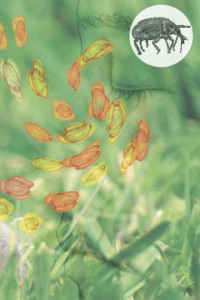You love living in Santa Rosa, but sometimes you might find yourself dealing with problems that make the whole experience more difficult than it should be. Have you ever noticed yourself frequently sneezing, itching, or experiencing red eyes and coughing? If you answered “yes” to any of the above, you might be having an allergic reaction to dust mites in your home. Before you panic though, make sure to learn more about this problem so that you can discover how to get rid of dust mites and restore your dwelling to a more comfortable state.
Wondering How to Get Rid of Dust Mites Entirely? Read This First
 There is good news and bad news to be had when you first discover a dust mite problem in your home. Let’s start with the bad news: if you’re wondering how to get rid of dust mites completely, the short answer is that you can’t. Dust mites naturally live in houses, commercial buildings, and any other indoor area with carpets, cushions, mattresses, or upholstered furniture. They’re also microscopic, which means that you can’t just go around crushing them out of existence. Ready for the good news? Here it is: dust mites don’t bite, they won’t eat your food, they don’t make any annoying noises, and you won’t ever see them crawling around unless you happen to always carry a microscope with you.
There is good news and bad news to be had when you first discover a dust mite problem in your home. Let’s start with the bad news: if you’re wondering how to get rid of dust mites completely, the short answer is that you can’t. Dust mites naturally live in houses, commercial buildings, and any other indoor area with carpets, cushions, mattresses, or upholstered furniture. They’re also microscopic, which means that you can’t just go around crushing them out of existence. Ready for the good news? Here it is: dust mites don’t bite, they won’t eat your food, they don’t make any annoying noises, and you won’t ever see them crawling around unless you happen to always carry a microscope with you.
Five Easy Steps to Reduce Dust Mite Symptoms
Here’s some even better news: you can take steps to prevent dust mites from thriving in your home, and it’s relatively easy to keep their presence in your dwelling low. We’ve found the following strategies to be of excellent use when dust-mite-proofing a home:
- Use damp rags and mops to dust instead of dry cloths or feather dusters. One of the first things any homeowner should understand about dust mites is that they can be kicked up by many everyday household chores. Sweeping, vacuuming, and even dusting usually tend to increase the number of dust mites in the air, rather than lowering it. When this happens, they will be more likely to land on your skin, and you will be more likely to breathe them in—both of which can be irritating. As such, you want to avoid any activities that are likely to dislodge the dust mites living on surfaces in your home. Dusting with a wet cloth ensures that the mites will stick to it instead of being brushed up and into the air.
- Wash your bedding and blankets weekly. Dust mites are so named because they love surfaces where dust accumulates quickly. Your sheets and blankets are a prime example, so it’s up to you to be proactive and prevent them from becoming dusty over time. Washing them with hot water once a week will do wonders.
- Replace wool and feathered bedding with synthetic fabrics. Dust mites find wool and other natural fabrics much more natural to live on than synthetic materials, so consider replacing your bedding. Synthetic fabrics have other advantages, too—they may be more cost-effective, and require less maintenance than their organic counterparts.
- Consider investing in hardwood flooring, linoleum, or tiles (depending on each room in question). Carpets can be some of the most fertile surfaces for dust mites to occupy, so you might want to consider replacing yours with hard and smooth surfaces (besides, what is this—the 1970s?). Hardwood makes a wonderfully modern addition to most living and dining rooms, while tiles are excellent in bathrooms and linoleum still works wonders in a kitchen—which should be one of the last places you want tiny insects living, anyway.
- Use your air conditioner often, and take care to maintain it properly. Perhaps the best way to make your home inhospitable for dust mites is to keep your air conditioner active. The more you use your air conditioner, the more air will circulate throughout your home and the better it will be treated. As a result, two important things will happen: firstly, dust will have a harder time settling on the surfaces in your home, and secondly, the air that enters your home will be cleaner in the first place. Just make sure that you change your AC filters at least once a month while your system is in use, and arrange for duct cleaning every 2-5 years by a licensed professional so that you can enjoy consistent results from your HVAC.
- Dust mites are never pleasant, but they aren’t the end of the world—and you can always take steps to minimize the impact they will have on your home and its rightful inhabitants. Use the guide above to start mite-proofing your home, and you should notice the difference almost immediately. Stop wondering how to get rid of those dust mites, and start kicking them out today.
Check with us here at Valley Comfort Heating and Air, our customers love our attention to detail and our friendly, affordable service. (707) 539-4533

